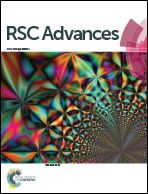A general approach for synthesis of functional metal oxide nanotubes and their application in dye-sensitized solar cells†
Abstract
TiO2, SnO2, ZnO, Fe2O3, and ZrO2 nanotubes were synthesized through a combination of templating and solvothermal processes. Selenium nanowires have been used as a template for the first time to synthesis a family of functional metal oxide nanotubes. The nanotubes so obtained were composed of fine particles with sizes as small as 6–8 nm. These nanotubes were characterized by scanning electron microscopy (SEM), X-ray diffraction (XRD), transmission electron microscopy (TEM) and Raman spectra. The influence of TiO2 nanotubes on the performance of dye-sensitized solar cells (DSSCs) based on the TiO2 nanotube/nanoparticle composite films was investigated. The power conversion efficiency of DSSC was enhanced from 5.84% for the pure nanoparticle film to 6.66% for the composite film with 10 wt% nanotubes. Advantages of this method include that it is a simple and general process that can open new avenues for the synthesis of a variety of functional nanotube structures.


 Please wait while we load your content...
Please wait while we load your content...